As of 2023, over 90% of businesses felt confident that their social media marketing efforts would produce a positive return on investment.
This not only speaks to the power of social media marketing but also points to the importance of tracking social media metrics properly.
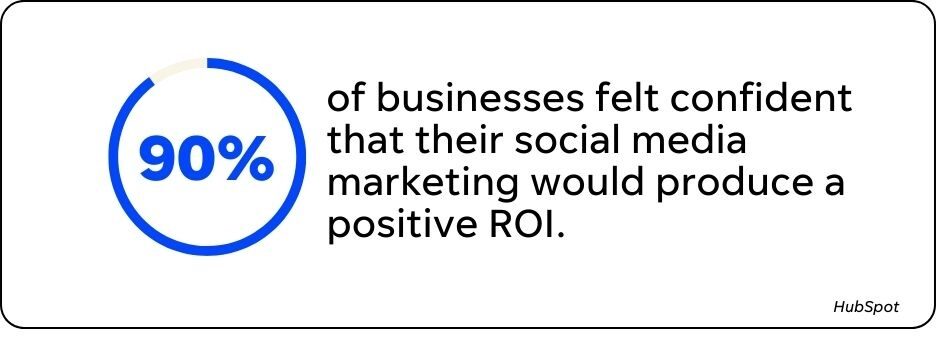
Like these marketers, you want to be able to prove that your social media strategy is working (and be confident that it will keep working). Let’s get into what metrics to track, why, and how.
What are social media metrics?
If you’re wondering what social media metrics even are, don’t worry! We’ve got you covered. Social media metrics are a collection of different data points used to define how your social media marketing is impacting your business. You can use social media metrics to know which social strategies make a difference for your business’s bottom line.
Why track social media metrics?
In social media marketing, too many people focus on so-called “vanity metrics” like follower count. As a result, some others think that tracking social media performance is a distraction from real business results like sales.
In reality, though, social media has driven meaningful results for countless businesses. And not only that but, 85% of executives see it as a top source of reliable business intelligence. After all, social platforms allow you to observe and interact with ideal customers in a place where they’re comfortable, gathering unfiltered insights to help with your decision-making.
Ultimately, tracking social media metrics helps you:
- Gauge the effectiveness of your social media marketing strategy and reveal areas to improve.
- Determine how much of your budget should be allocated to social media marketing (and justify your number if you need to get approval from a decision-maker).
- Gauge the effectiveness of messaging on and off social media to find opportunities for improvement.
- Keep tabs on the overall health of your brand.
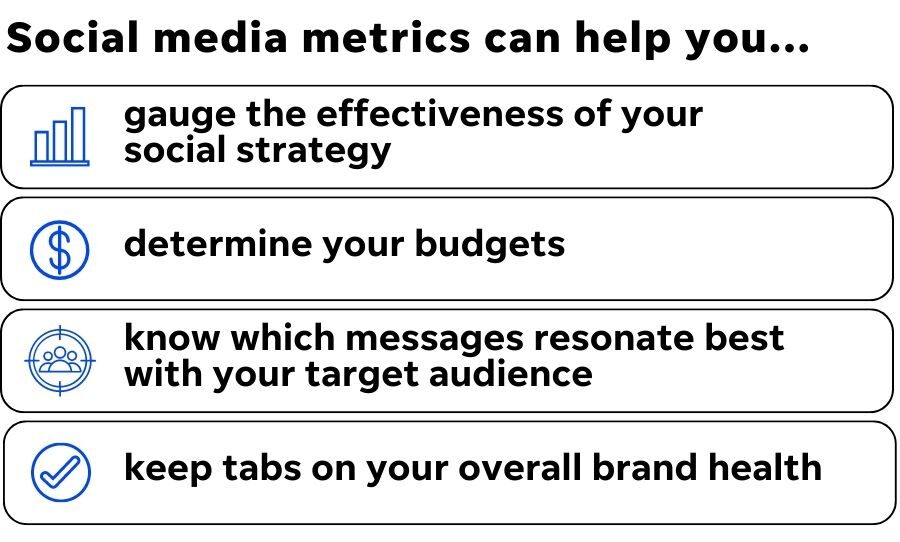
But not all metrics are of equal importance. We’ll get into the most important ones to track next.
5 most important social media metrics to measure
There are both quantitative and qualitative metrics for understanding how effective your social media marketing strategy is (or isn’t).
1. Referral traffic
Referral traffic is what it sounds like—traffic to your website with the referral source being a social media platform like Facebook, Instagram, Twitter, or Tik Tok. This is cosidered the top social media metric for organic and paid social marketing. Now, you might be wondering, why, exactly, is tracking referral traffic so valuable to businesses.
It reveals which types of social media content do the best job of engaging your audience so you can create more of it. Besides this, it opens the way for conversions or sales, which often happen on your website or in your ecommerce store rather than directly on social media.
Since referral traffic from social media is up on many platforms, you have more opportunities than ever to drive conversions.
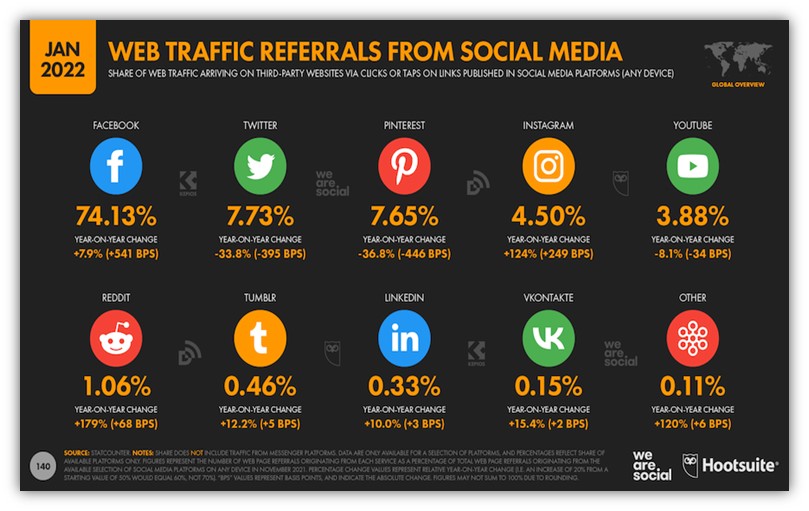
2. Click-through rate (CTR)
Related to referral traffic is another metric called click-through rate. It’s the measure of how many times a link was clicked vs how many times it was displayed. Say, for example, that your social media ad was displayed 500 times and 75 people clicked through to your landing page. It would have a CTR of 15%.
The higher your click-through rates to your website or social media landing pages are, the better you are at persuading your social media audience to take actions like converting or making a purchase.
3. Conversion rate (CVR)
The word “conversions” is often used interchangeably with “sales,” since increasing sales is the ultimate goal for most businesses. However, “conversions” can really refer to any action you want your audience to take, such as subscribing to your email newsletter, downloading a lead magnet, or filling out a form.
So, conversion rate is the percentage of people who took the desired action out of the total number of people who engaged with your content. Think back to our CTR example where 75 people clicked through from your ad to your landing page. If 7 of those people signed up for your offer on the landing page, your conversion rate would be about 10%.
Generally, the higher your conversion rate, the better the return on investment. Find more conversion metrics to pay attention to here.
4. Cost per click (CPC)
CPC is an advertising-specific metric that refers to how much you pay for each click on one of your social ads or promoted posts. It can help you figure out how effective your marketing is.
For example, imagine your cost-per-click is high but you’re getting few to no conversions. In other words, the money you’d be spending on a Facebook ad, let’s say, wouldn’t be making you more money. With that knowledge, you can work to find the culprit.
If you’re getting clicks, something about your ad is attention-grabbing. What goes wrong after your audience clicks? Perhaps your landing page copy is unclear about your offer or its benefits. Whatever the issue may be, you can test incremental changes to see how they affect the key performance indicators (KPIs) you’re tracking.
5. Share of voice
How much is your company being talked about compared to competitors? The answer is your share of voice. This is a measure of the awareness of your company and how much of the conversations in your industry revolve around your brand.
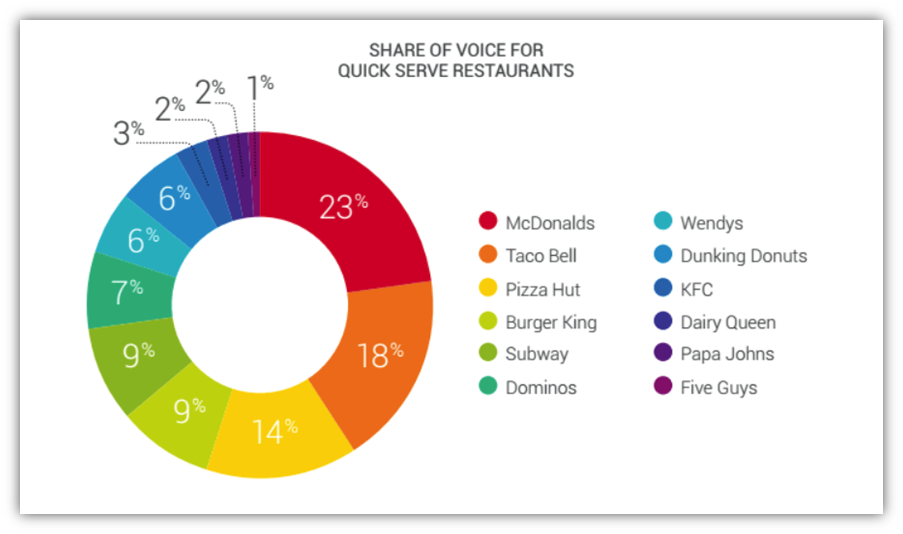
When combined with sentiment analysis to confirm that the conversations about your brand are positive, share of voice can be a telling metric. It means that you are being noticed, earning respect, and that your reach and ability to attract potential customers is increasing.
4 more social media metrics to track
Now that we know which social media metrics are most important to track, let’s discuss some of the ones you may want to keep an eye on. These social media metrics don’t directly tie back to business goals like revenue generation and/or can be artificially inflated to make a business look more successful than it is. But these social media metrics may be helpful to track based on your goals.
Here are four more social media metrics to keep an eye on:
1. Impressions
This refers to the number of times your content had been displayed to users, including repeat views. Impressions aren’t the most important metric to measure but looking at this metric can be helpful in understanding if your content is getting seen.
(Get a deep-dive into the differences between impressions vs. clicks here.)
2. Reach
Reach is the number of unique people who’ve seen your content. When you’re running organic social media marketing, you may notice that your reach is lower. This could be a sign that you may want to invest in social advertising so you can show your content to more people and build up your audience.
3. Engagement rate
Engagement rate includes likes, comments, and shares. You want to shoot for a high engagement rate because it means people are interacting with the content you’re posting on social media. A low engagement rate could indicate the need to adjust your social media strategy and the type of content you’re sharing.
4. Follower count
This is the number the people who’ve subscribed to see your content on their feeds. Follower count isn’t as important as engagement rate or other metrics, but it can be helpful for benchmarking the progress of your social media marketing strategy.
These metrics are most useful when they’re linked to your current business objectives and lead to improvements in the more valuable metrics above.
For instance, say the top brand in your industry holds the majority of the market share and has over a million engaged followers on social. Do you think reach would be a critical metric for it to measure? Probably not since most of its content will automatically have a wide reach at this point. On the other hand, reach may be good for a new small business with a brand-new social media presence to measure. After all, it will be trying to get the word out to potential customers and build trust. Context is key.
How to measure social media metrics
Follow these steps to track, measure, and analyze your social media metrics.
1. Set social media goals
Tracking social media metrics isn’t just looking over your analytics periodically; it’s looking over your analytics with a purpose. Whether you’re looking to drive brand awareness, make sales, or do anything else, you need a target in mind. Otherwise, it will be needlessly difficult to gauge how far you have left to go, or if you’re progressing quickly enough to make a real business impact.
There may be exceptions, but as a general rule of thumb, your social media marketing goals should be:
- Brand awareness if your company is new or relatively unknown (even just on social media)
- Engagement if you’ve already generated some awareness
- Lead generation if you’ve got an engaged audience
- Conversions if you’re already generating leads via social
- Customer service If you’ve had success driving sales or other conversions using social media
To help set your social media goals, try the SMART goal structure—which stands for specific, measurable, achievable, relevant, and time-bound. Each goal you set should be specific and have a time limit on it.
Instead of saying, “We want to increase conversion rate,” get more detailed. \Set goals like, “We will increase our conversion rate from 3% to 10% within the next three months by conducting A/B tests on the landing page copy.” That way, there will be no confusion about whether you have or haven’t reached your objective when evaluating results.
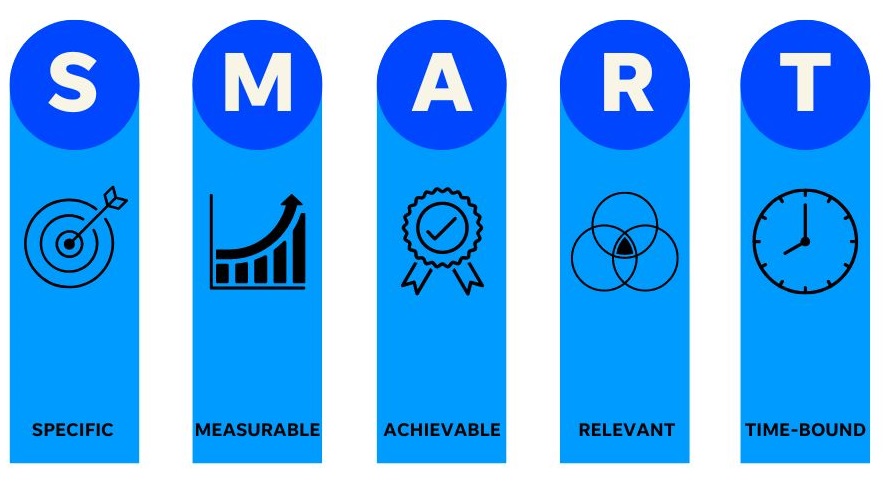
2. Choose the right social media metrics to track
Based on the social media goals you set for your business, determine the metrics you’ll need to keep an eye on. For example, share of voice and mentions map to brand awareness, while click-through rate and cost-per-click map to lead generation. If you’re already active on social media, record what those metrics look like now and set a specific goal for the improvement you’d like to see within a certain timeframe.
You’ll also want to re-evaluate what you’re tracking periodically since it will vary based on the stage of business and social media success you’re at. To ensure that your social media strategy stays effective, you need to adapt your goals and the tactics you use to reach them. Ideally, you should do a quarterly evaluation but, at the very least, do one every six months.
3. Use the right tracking tools
You have a few options for tracking the key performance indicators you decide on.
Built-in analytics tools
All major social media platforms from TikTok to Facebook to LinkedIn have analytics features. If you’re focusing on just one or two platforms, you may be able to get by using these built-in analytics dashboards. As long as all the KPIs you want to track are available there, of course.
However, that may not be the best solution if you’re active on several social media sites. In that case, you’ll want all of your analytics data unified in one centralized dashboard.
Social media tools
There are plenty of marketing tools that pull data from your social channels into one place. LocaliQ, Buffer, Hootsuite, and Sendible are all examples of social media solutions that can help you keep an eye on your metrics.
![]()
If you’re using these or similar social media management tools but not taking advantage of the analytics features, now’s the time to change that.
Google Analytics or web traffic tools
If you’re trying to measure a social media metric like referral traffic, you’ll want to switch to GA4 or a similar tool that measures website traffic. Google Analytics can let you know which social media site is sending traffic to your website, which can help you gauge the effectiveness of your social media strategy. And if you use tracking parameters like UTMs, you can get an even deeper look at which campaigns are driving traffic to your website.
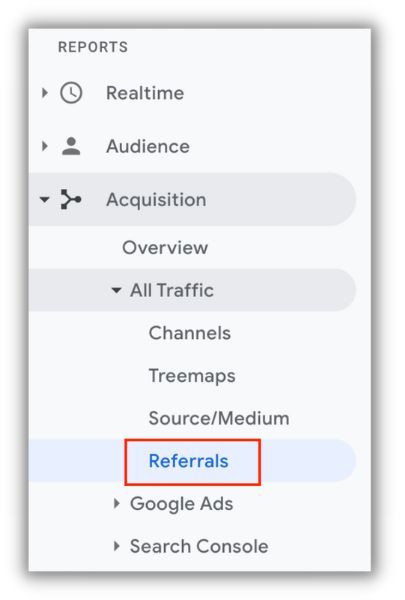
4. Look at performance by platform
When trying to determine where your social media marketing efforts are working best, you might compare metrics one to one. But, while two platforms may both measure a metric like click-through rate, there are differences to keep in mind. A big one is audience.
There may be variances in which groups within your target market use which social media platforms. Imagine a scenario like this: You have a 19% CTR on Instagram and only 11% on Facebook. Your conversion rates are the same on both platforms.
If you were looking at CTR alone, you might think Instagram is your top performer and deserves more of your focus. But that wouldn’t be true if, for example, your Facebook audience is financially more well-off and consistently had a higher average order value. You need to look at the full picture (whether you’re evaluating metrics from one platform or across several).
5. Analyze metrics over time
If you only ever compare this month’s metrics to the month or two before, you’re missing out on insights that could make your strategy more impactful going forward. Comparing where you are today vs. where you were six months or a year ago can reveal important patterns.
For example, if you notice your engagement rate consistently drops at certain points in the year, you can plan ahead to boost engagement during that time.
Start tracking your social media metrics for success (the right way)
Now that you know what not to do, it’s time to evaluate (or re-evaluate) what metrics you should be tracking. To recap, here are the most useful social media metrics:
- Referral traffic
- Click-through rate
- Conversion rate
- Cost-per-click
- Share of voice
But remember that the metrics you should keep tabs on depend on your current business and marketing situation, and your business and social media goals. In some cases, even metrics like reach and engagement rate can be helpful indicators that your social media strategy is working. So, think through what you’d like to accomplish by way of social media in the next three to six months. Then, determine what metrics map back to that goal, and start tracking!






